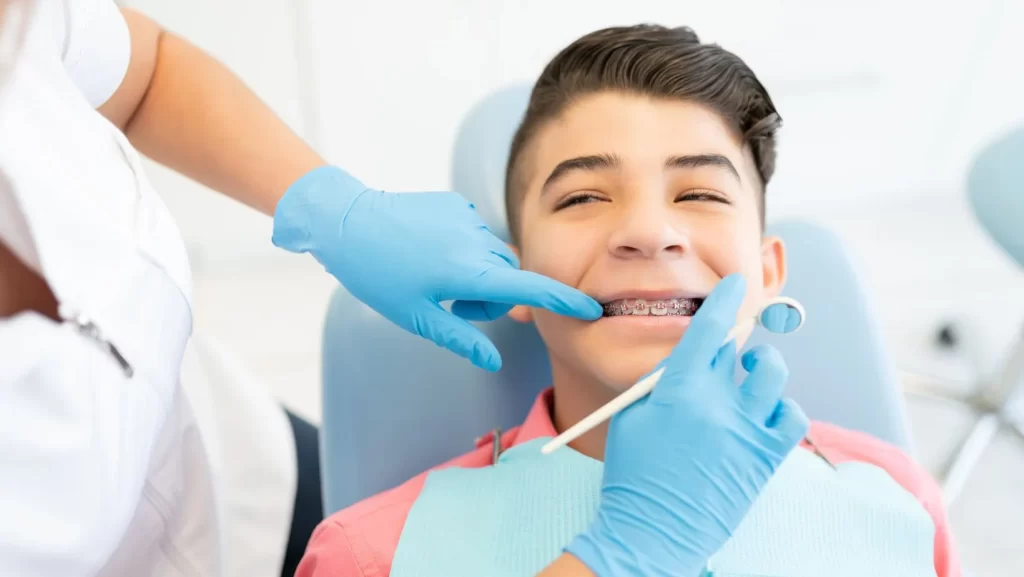Orthodontists
- Home
- Orthodontists
Orthodontic treatment can be especially beneficial for children, as it can help correct dental and facial irregularities early on, leading to improved oral health and a more aesthetically pleasing smile. Let’s take a closer look at why orthodontic treatment is important for children and what parents can expect during the treatment process. Orthodontic treatment can be especially beneficial for children, helping to correct dental and facial irregularities early on and leading to improved oral health and a more aesthetically pleasing smile. If you’re a parent, it’s important to have your child evaluated by an Orthodontist by the age of 7 to identify any potential issues that may benefit from early intervention. With the right treatment and care, children can enjoy a lifetime of healthy teeth and a beautiful smile.
Choosing the right Orthodontist is an important decision that can impact the success of your orthodontic treatment.

What is an Orthodontist?
An Orthodontist is a dental specialist who focuses on the diagnosis, prevention, and treatment of dental and facial irregularities. These irregularities may include crooked teeth, overcrowding, underbites, overbites, and misaligned jaws. Orthodontists receive an additional 2-3 years of specialized education after completing dental school, making them experts in the field of orthodontics.
What Services do Orthodontists offer?
Orthodontists offer a range of services to correct dental and facial irregularities. Some of the most common services include traditional braces, clear aligners, and retainers. Braces are the most common form of orthodontic treatment, using brackets and wires to gradually move teeth into their correct position. Clear aligners, such as Invisalign, are becoming increasingly popular for their discreet appearance and convenience. Retainers are often used after braces or clear aligner treatment to maintain the new position of teeth.
How To Find the best Orthodontist for your needs!
When it comes to choosing an Orthodontist, it’s important to find someone who is highly trained and experienced. You may want to start by asking your regular dentist for a referral, or by searching online for local Orthodontists. Reading reviews from previous patients can also help you get an idea of the quality of care provided by different Orthodontists. Additionally, many Orthodontists offer a free initial consultation, which can be a great opportunity to meet the Orthodontist and ask any questions you may have.
Orthodontists vs. General Dentists
While general dentists provide a wide range of dental services, including routine check-ups, cleanings, and fillings, Orthodontists have additional training in correcting dental and facial irregularities. Orthodontists use various tools and techniques to help align teeth and jaws, including braces, clear aligners, and retainers. In contrast, general dentists may refer patients to an Orthodontist for specialized orthodontic treatment.
Different Types of Orthodontic Treatments.
There are several types of orthodontic treatments available, including traditional braces, clear aligners, and retainers. The type of treatment recommended will depend on the patient’s individual needs and goals. Let’s take a closer look at each type of treatment.
Traditional Braces:
Traditional braces are the most common form of orthodontic treatment. They consist of brackets and wires that gradually move teeth into their correct position. Braces can be used to correct a range of dental and facial irregularities, including crooked teeth, overbites, and underbites. While braces are effective, they can be uncomfortable and require regular adjustments from an Orthodontist.
Clear Aligners:
Clear aligners, such as Invisalign, are becoming increasingly popular for their discreet appearance and convenience. Unlike traditional braces, clear aligners are made from a clear plastic material that is nearly invisible when worn. Patients wear a series of aligners that gradually move teeth into their correct position. Clear aligners are a great option for patients who want to straighten their teeth without the noticeable appearance of traditional braces.
Retainers:
Retainers are often used after braces or clear aligner treatment to maintain the new position of teeth. They are custom-made to fit each patient’s unique needs and are designed to be worn for a certain amount of time each day. Retainers are an essential part of orthodontic treatment, as they help ensure the long-term success of treatment.
Benefits of Orthodontic Treatment:
Orthodontic treatment offers several benefits, both cosmetic and functional. Let’s take a closer look at some of the most significant benefits of orthodontic treatment.
Improved Oral Health:
Orthodontic treatment can help improve overall oral health by making it easier to clean teeth and gums. When teeth are properly aligned, it is easier to brush and floss, reducing the risk of tooth decay, gum disease, and other dental problems.
Improved Appearance:
Orthodontic treatment can improve the appearance of teeth and jaws, creating a more aesthetically pleasing smile. Straight teeth can also boost confidence and self-esteem.
Improved Speech:
Misaligned teeth and jaws can affect speech, making it difficult to pronounce certain sounds. Orthodontic treatment can help correct these issues, improving speech and communication.
Improved Chewing and Digestion:
When teeth are properly aligned, it is easier to chew food, which can improve digestion and overall health.
Why Orthodontic Treatment is Important for Children?
Orthodontic treatment can benefit children in several ways. For one, it can help correct common dental and facial irregularities, such as crooked teeth, overbites, and underbites. By correcting these issues early on, children can avoid more severe dental problems down the line, such as tooth decay and gum disease.
Orthodontic treatment can also improve a child’s confidence and self-esteem. Children with misaligned teeth or jaws may feel self-conscious about their smile, leading to social anxiety and other emotional issues. By straightening their teeth, children can feel more confident and comfortable in social situations.
When to Begin Orthodontic Treatment?
The American Association of Orthodontists recommends that children receive an orthodontic evaluation by the age of 7. At this age, the Orthodontist can identify any dental or facial irregularities that may benefit from early intervention. While not all children will require early orthodontic treatment, early evaluation can help identify potential issues before they become more severe.
Types of Orthodontic Treatment for Children.
There are several types of orthodontic treatment available for children, including traditional braces, clear aligners, and retainers. The type of treatment recommended will depend on the child’s individual needs and goals.
Traditional Braces:
Traditional braces are the most common form of orthodontic treatment for children. They consist of brackets and wires that gradually move teeth into their correct position. Braces can be used to correct a range of dental and facial irregularities, including crooked teeth, overbites, and underbites. While braces are effective, they can be uncomfortable and require regular adjustments from an Orthodontist.
Clear Aligners:
Clear aligners, such as Invisalign, are becoming increasingly popular for their discreet appearance and convenience. Unlike traditional braces, clear aligners are made from a clear plastic material that is nearly invisible when worn. Children wear a series of aligners that gradually move teeth into their correct position. Clear aligners are a great option for children who want to straighten their teeth without the noticeable appearance of traditional braces.
Retainers:
Retainers are often used after braces or clear aligner treatment to maintain the new position of teeth. They are custom-made to fit each child’s unique needs and are designed to be worn for a certain amount of time each day. Retainers are an essential part of orthodontic treatment, as they help ensure the long-term success of treatment.
What to Expect During Orthodontic Treatment.
Orthodontic treatment can take several months or even years, depending on the child’s individual needs and goals. During this time, children will need to visit the Orthodontist regularly for adjustments and check-ups.
Parents can help their children feel more comfortable during the treatment process by providing them with proper oral hygiene tools, such as a toothbrush and floss, and encouraging them to follow a healthy diet.
Find The Best Orthodontist Today!
Find And Review Local Orthodontist Offices
On The Dental Office Network!

